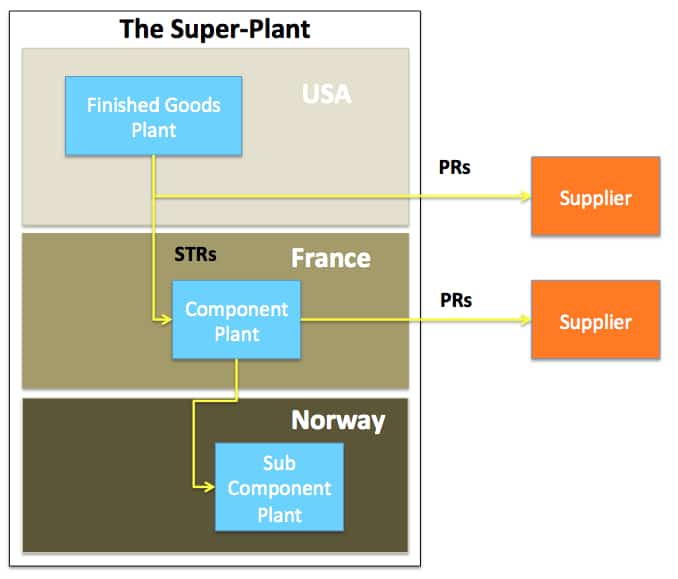How to Understand Multi Plant Planning Stock Transfers
Executive Summary
- The standard production design that most supply and production planning systems for.
- Multi plant planning is an advanced form of supply chain planning.
- We cover capacity planning in the superplant.
- There is a prioritization of internal stock transfers over external customer orders for subcomponents.

Introduction to Multi Plant Planning
Multi plant planning is a rarely accessed functionality.
This article will learn about the standard production planning process and contrast it to the multi plant planning requirement.
Our References for This Article
If you want to see our references for this article and other related Brightwork articles, see this link.
Notice of Lack of Financial Bias: We have no financial ties to SAP or any other entity mentioned in this article.
- This is published by a research entity, not some lowbrow entity that is part of the SAP ecosystem.
- Second, no one paid for this article to be written, and it is not pretending to inform you while being rigged to sell you software or consulting services. Unlike nearly every other article you will find from Google on this topic, it has had no input from any company's marketing or sales department. As you are reading this article, consider how rare this is. The vast majority of information on the Internet on SAP is provided by SAP, which is filled with false claims and sleazy consulting companies and SAP consultants who will tell any lie for personal benefit. Furthermore, SAP pays off all IT analysts -- who have the same concern for accuracy as SAP. Not one of these entities will disclose their pro-SAP financial bias to their readers.
The Standard/Traditional Production Planning Process
Supply planning and production planning systems are designed to schedule a finished good, which has a bill of material connected to various subcomponents and raw materials that are then procured in the right time and quantity to support that finished good production. The production process has two important components:
- The bill of material is exploded in one location.
- The production takes place in one location.
Now that we have outlined the process flow for the standard production planning process let’s move to the multi plant planning process.
Mult Plant Planning
Multi plant planning is essentially a division of the various production steps into different locations.
Therefore a company may use several factories close to each other and, in other cases, in different countries to perform different steps of the manufacturing process for different subcomponents. The difference is that the subcomponents are received into the plant that performs final assembly with stock transport orders rather than purchase orders.
Several important sub-issues arise because of this design:
- Stock Transports
- Stock Transport Requisitions
Stock Transports
How should the stock transports be controlled between the factories? This may be designed to differ based upon whether the plants are within proximity to one another or are distant. This topic is described in detail in this article (adjust the article on integrated factories to consider integrated factories nearby versus factories that are very distant from one another).
Stock Transport Requisitions
Stock transport requisitions (the precursor to STOs) are treated differently by SAP APO than purchase requisitions (the precursor to POs). For instance, the purchase requisition creation is part of the initial supply plan, while the stock transport requisition is an output of the deployment plan. A purchase requisition for a component can have purchase requisitions created for the sub-components below the component. However, a stock transport requisition is designed to request a transfer of a different internal facility component. If a component is managed internally, its capacity is often much easier to model (companies that successfully model their supplier capacity are still relatively rare, although a PPM can be created in a vendor location in APO, so it is technically possible).
However, it raises interesting questions concerning how the procedure, let us say CTM, drives the demand through the various plants. The graph below shows how transferring subcomponents between internal locations differ from producing a single location exclusively with purchase requisitions.

Essentially the dependent demand that “waterflows” cleanly through the bill of material when production is performed in a single location is broken up into subunits or sub-bills of material as the stock transfer requisitions are passed between various locations. It also means that the bill of materials is aggregated at the final assembly location. The real bill of materials is a composite made up of “miniature” bills of materials distributed in different locations.
The Fractured Bill of Material
Although tangential, this is a fractured and distributed bill of material and quite different from the bill of material developed and used by engineering and design when it was creating the product design. This highlights the differences between the bills of material as presented to different groups within a company and is an excellent example. Still, one of many may be presented as to why the ERP system should never record the bill of materials.
Capacity Planning the Superplant
When it comes to capacity planning, the resources are also distributed across locations. This means that constraining a full production (from raw material to finished goods) process by a bottleneck resource is now not feasible. Instead, the material constraints are (from internal locations that produce the subcomponent) used to determine feasibility. Therefore, while breaking up the production process in this way certainly has many advantages, it also makes planning more complex, and will result in less visibility (in practical terms), and will tend to result in higher inventory as the linkages are less controllable and less direct.
That is unless the company has multi plant planning functionality in their production planning software.
Prioritizing Internal Demand for Sub-Components Over External Demand
Many companies that both use and sell components prioritize the internal demand for components and subcomponents over external customers. This makes sense from a profitability perspective, as their profit margins on finished goods are higher than that for components. Therefore, a supply planning procedure that can control the initial supply and production plan with resource constraints and prioritize demand types is desired. This, of course, is exactly what CTM does. In the Superplant, demand type prioritization is important because if a company were to allow an external customer to consume capacity for a component for which there is internal demand. Then the in-process portions of the finished good would sit in inventory until the component can be produced, which is, of course, an undesirable outcome.
When a company wants to prioritize internal demand over external demand, it will make sense to run CTM with stock transfer requisitions set as a higher priority than sales orders. Sales orders do not consume components that internal factories need.